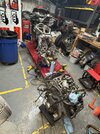This is an idle conversation...
I've started doing some more research into the "wax idle valve", which apparently is no longer wax, but it a bimetal thermo-mechanical device.
The cold-idle is set by the "wax idle valve", and is pre-set at the factory. But several people on online forums with several different honda motorbike models have reported issues with the preset adjustment.
Some people have reported that gas mileage improves with corrected settings.
The warm idle setting shouldn't be resultant on the cold setting, but they may interact with each other.
A few FB group members mentioned that the feed line for the coolant going to the wax idle valve can get clogged (the portion on top of the radiator - top right - that built up corrosion impeding coolant flow for one guy, vs a chip that clogged the intake of the wax unit for another), and when the obstructions were cleared it improved flow, the wax idle valve worked better and the bikes exhibited improved fuel consumption.
So, here's my present situation...
AFTER I changed to 10W30, my bike no longer idles high (3000rpm) after a minute or two of 2000rpm. I thought this was very interesting and peculiar. The high 3000rpm idle when "cool" (not cold) seems to be an issue with the wax idle valve setting and/or coolant flow.
Also, for now, since I didn't want to fully remove my airbox again, I adjusted my warm idle a bit lower. It had been acting strange... Once warm, it would go to the idle where I set it, but then when the bike was "hot" (ie: drive 20min or more), the idle speed would increase. So, for numbers... If I set it at 900rpm (warm idle), the idle would increase to 1100-1300rpm when hot.
Add to this, I was getting 15km/litre, 80 to 90 percent highway driving, mostly near 100-115kph. That's 35.3 US-mpg... Pretty trashy!!
So, after lowering my idle (when HOT, it idles at target 1000rpm+-100rpm), I noticed a vastly improved fuel economy (up to 15-20% improvement depending on speed) - when the bike is hot. Of course, now when the bike is WARM, I have to be careful because the rpm is lower than desired (near 750rpm).
So, as you guys all know, it's a chore to remove the plastics. But I plan to remove them to do some cleaning and maintenance as one guy suggested. It is less of a chore to fully remove the airbox and move the wax idle setting (a few people suggested loosening the stop-nut a quarter turn or so). It's a bummer to have to do that, re-build the airbox, test, then rinse and repeat... But, if I do it once, or even twice, it's still easier than removing the plastics, and I can find out what the effect is.
Have any of you guys had any experience with the wax idle valve...??
There's a few great videos on youtube (honda vfr800) showing how the wax idle valve and warm idle adjustments actually work. Here's some screenshots for the video. And you can search for "honda motorcycle wax idle valve" and find some info on youtube and forums on the internet.
Thanks for any thoughts y'all might have...
I've started doing some more research into the "wax idle valve", which apparently is no longer wax, but it a bimetal thermo-mechanical device.
The cold-idle is set by the "wax idle valve", and is pre-set at the factory. But several people on online forums with several different honda motorbike models have reported issues with the preset adjustment.
Some people have reported that gas mileage improves with corrected settings.
The warm idle setting shouldn't be resultant on the cold setting, but they may interact with each other.
A few FB group members mentioned that the feed line for the coolant going to the wax idle valve can get clogged (the portion on top of the radiator - top right - that built up corrosion impeding coolant flow for one guy, vs a chip that clogged the intake of the wax unit for another), and when the obstructions were cleared it improved flow, the wax idle valve worked better and the bikes exhibited improved fuel consumption.
So, here's my present situation...
AFTER I changed to 10W30, my bike no longer idles high (3000rpm) after a minute or two of 2000rpm. I thought this was very interesting and peculiar. The high 3000rpm idle when "cool" (not cold) seems to be an issue with the wax idle valve setting and/or coolant flow.
Also, for now, since I didn't want to fully remove my airbox again, I adjusted my warm idle a bit lower. It had been acting strange... Once warm, it would go to the idle where I set it, but then when the bike was "hot" (ie: drive 20min or more), the idle speed would increase. So, for numbers... If I set it at 900rpm (warm idle), the idle would increase to 1100-1300rpm when hot.
Add to this, I was getting 15km/litre, 80 to 90 percent highway driving, mostly near 100-115kph. That's 35.3 US-mpg... Pretty trashy!!
So, after lowering my idle (when HOT, it idles at target 1000rpm+-100rpm), I noticed a vastly improved fuel economy (up to 15-20% improvement depending on speed) - when the bike is hot. Of course, now when the bike is WARM, I have to be careful because the rpm is lower than desired (near 750rpm).
So, as you guys all know, it's a chore to remove the plastics. But I plan to remove them to do some cleaning and maintenance as one guy suggested. It is less of a chore to fully remove the airbox and move the wax idle setting (a few people suggested loosening the stop-nut a quarter turn or so). It's a bummer to have to do that, re-build the airbox, test, then rinse and repeat... But, if I do it once, or even twice, it's still easier than removing the plastics, and I can find out what the effect is.
Have any of you guys had any experience with the wax idle valve...??
There's a few great videos on youtube (honda vfr800) showing how the wax idle valve and warm idle adjustments actually work. Here's some screenshots for the video. And you can search for "honda motorcycle wax idle valve" and find some info on youtube and forums on the internet.
Thanks for any thoughts y'all might have...



